| I was looking through my photo files and stumbled
across some photos from a few river trips I have taken
over the last year or so. Never got around to writing
up a story about any of them, but there were some
nice photos of some good times, so I thought I would
whip something up.
Last summer I spent an afternoon paddling down the
Sevre Niortaise. This is a smallish river that runs
through an area of South-western France called the
Poitou Swamp (it sounds better in French, le Marais
Poitevin). It is basically an ancient bay, dotted
with limestone islands that has been silting up gradually
over the years. Starting about 1,000 years ago, the
locals started accelerating the process, digging channels,
building dikes, and filling where they could. Today
it is known as Green Venice, because of all the tiny
little channels that spread out like a net through
the small islands and the villages perched on the
old limestone islands. It is a pretty place.
| 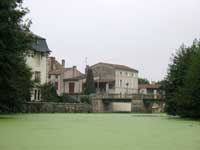 Magne’
: Nice little town, lots of old stone. The first
couple of mile of paddling was pretty tough,
plowing through weed. If one got a good running
start, one could probably run across the river
in this part. Magne’
: Nice little town, lots of old stone. The first
couple of mile of paddling was pretty tough,
plowing through weed. If one got a good running
start, one could probably run across the river
in this part.
(click
images to enlarge) |
| 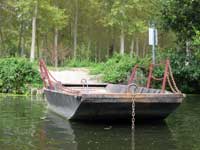 A
wooden chain ferry, built to take livestock
or whatever across the river to the big, artificial
island built up with dirt dug out of the canals
around it. I have seen a couple of these getting
built, and they are usually oak covered with
hot road tar. A
wooden chain ferry, built to take livestock
or whatever across the river to the big, artificial
island built up with dirt dug out of the canals
around it. I have seen a couple of these getting
built, and they are usually oak covered with
hot road tar.
|
| 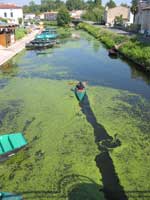 Paddling
down through the middle of Coulon. Nice little
town, built on the trade up and down the Sevre
Niortaise, it spent many years in the doldrums
after rail and road transport eclipsed river
transport. Now it is a pretty quiet little country
town that attracts a fair number of tourists
and wealthy outsiders who own second homes there. Paddling
down through the middle of Coulon. Nice little
town, built on the trade up and down the Sevre
Niortaise, it spent many years in the doldrums
after rail and road transport eclipsed river
transport. Now it is a pretty quiet little country
town that attracts a fair number of tourists
and wealthy outsiders who own second homes there.
|
| 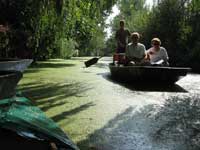 One
of the local swamp boats carrying tourists through
the canals around Coulon. There are still lots
of wooden ones around, but now they are mostly
made of fiberglass or steel, with more than
a few reinforced concrete ones. They are interesting
boats, a scow front with a canoe stern and are
always paddled -- an adaptation to the need
to carry heavy loads, timber or even a cow or
two through narrow waterways where the bottom
is too soft to pole, I guess. One
of the local swamp boats carrying tourists through
the canals around Coulon. There are still lots
of wooden ones around, but now they are mostly
made of fiberglass or steel, with more than
a few reinforced concrete ones. They are interesting
boats, a scow front with a canoe stern and are
always paddled -- an adaptation to the need
to carry heavy loads, timber or even a cow or
two through narrow waterways where the bottom
is too soft to pole, I guess.
|
| 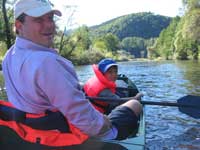 My
buddy Caleb and his son Rafael and I spent a
day on the Sieg River, a tributary to the Rhine
River near my home in Cologne. I hauled out
my folding pirogue for the trip. Beautiful day,
a lovely river, but it was rocky and a little
too shallow for the heavily loaded pirogue.
We ripped up the 6 mm ply on the bottom pretty
good, even cracked it in places. It didn’t
leak (I don’t understand why) but I am
either going to have to fiberglass the bottom,
or just retire the boat. Normally it lives in
my living room as two shelves (see Rhine Kanuen),
so I have been thinking of spiffing it up a
bit -- a new paint job, some more shelves, and
adding spacered oak inwales to dress it up a
bit. My
buddy Caleb and his son Rafael and I spent a
day on the Sieg River, a tributary to the Rhine
River near my home in Cologne. I hauled out
my folding pirogue for the trip. Beautiful day,
a lovely river, but it was rocky and a little
too shallow for the heavily loaded pirogue.
We ripped up the 6 mm ply on the bottom pretty
good, even cracked it in places. It didn’t
leak (I don’t understand why) but I am
either going to have to fiberglass the bottom,
or just retire the boat. Normally it lives in
my living room as two shelves (see Rhine Kanuen),
so I have been thinking of spiffing it up a
bit -- a new paint job, some more shelves, and
adding spacered oak inwales to dress it up a
bit.
|
| 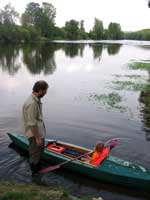 I
got a chance to take a couple of days in my
folding
kayak to camp along the Vienne River near
the in-laws’ place in Western France.
My daughter Rachel decided she wanted to try
Papa’s canoe, and was absolutely not happy
to see me paddling away alone... I
got a chance to take a couple of days in my
folding
kayak to camp along the Vienne River near
the in-laws’ place in Western France.
My daughter Rachel decided she wanted to try
Papa’s canoe, and was absolutely not happy
to see me paddling away alone...
|
| 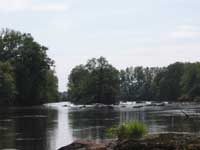 I
got a chance to run some rapids, easily Class
3 on the right side, in my folding skin boat.
She held up pretty well. I broke the paddle
off when it got caught between some stones (Next
project is to replace the plywood paddle ends
with solid wood) as I was coming down this bit,
and hit a couple of rocks pretty hard. But when
I pulled the boat out on the rocks to check
for damage, and line my way through the next
bit, I couldn’t even tell where I had
hit. Chalk one up for polyester reinforced PVC. I
got a chance to run some rapids, easily Class
3 on the right side, in my folding skin boat.
She held up pretty well. I broke the paddle
off when it got caught between some stones (Next
project is to replace the plywood paddle ends
with solid wood) as I was coming down this bit,
and hit a couple of rocks pretty hard. But when
I pulled the boat out on the rocks to check
for damage, and line my way through the next
bit, I couldn’t even tell where I had
hit. Chalk one up for polyester reinforced PVC.
|
| 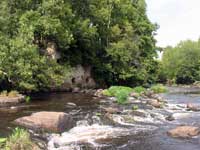 An
old abandoned mill and the remains of the weir.
The Vienne was lovely, but there was a weir
every 3-6 feet of fall in the course. Some of
them were easy to run or portage, but there
were a couple of awkward ones along the course.
I lined my way past this one. An
old abandoned mill and the remains of the weir.
The Vienne was lovely, but there was a weir
every 3-6 feet of fall in the course. Some of
them were easy to run or portage, but there
were a couple of awkward ones along the course.
I lined my way past this one.
|
| 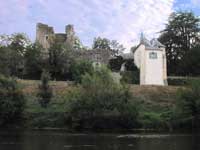 An
old, maybe 12th century castle, with a Baroque
chateau tacked on to one side. An
old, maybe 12th century castle, with a Baroque
chateau tacked on to one side.
|
| 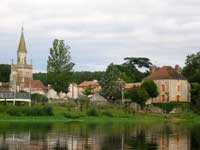 On
my third day out, I was getting a little fed
up with my leaky tent, and the weather showed
every sign of settling in for a good long rain.
I paddled into the happily named village of
Bonnes with its weird and wonderful 12th century
Romanesque church and called my wife to come
pick me up. It turned out she had some stuff
to do that morning, so we agreed to meet at
the next town, about 5 miles downstream. On
my third day out, I was getting a little fed
up with my leaky tent, and the weather showed
every sign of settling in for a good long rain.
I paddled into the happily named village of
Bonnes with its weird and wonderful 12th century
Romanesque church and called my wife to come
pick me up. It turned out she had some stuff
to do that morning, so we agreed to meet at
the next town, about 5 miles downstream.
|
| 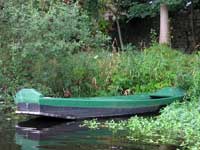 One
of the local river boats. They are made of local
pine, almost 2” thick and just sort of
nailed together and then coated with hot tar
to seal them. One interesting thing was the
way they let the bottoms overlap the sides,
bow and transom. I asked a couple of people
I met along the way, but was told it was just
the way it was done along the Vienne. I suspect
it was for two reasons. The bottom would tend
to rot in through the endgrain, and so if you
left an inch sticking out, it would take just
that much longer before it started loosening
up around the nails. Secondly, the Vienne is
pretty rocky in places and the exterior “chines”
would tend to protect the hull a bit better.
Though the things were built so heavily that
this might be a pretty minor consideration. One
of the local river boats. They are made of local
pine, almost 2” thick and just sort of
nailed together and then coated with hot tar
to seal them. One interesting thing was the
way they let the bottoms overlap the sides,
bow and transom. I asked a couple of people
I met along the way, but was told it was just
the way it was done along the Vienne. I suspect
it was for two reasons. The bottom would tend
to rot in through the endgrain, and so if you
left an inch sticking out, it would take just
that much longer before it started loosening
up around the nails. Secondly, the Vienne is
pretty rocky in places and the exterior “chines”
would tend to protect the hull a bit better.
Though the things were built so heavily that
this might be a pretty minor consideration.
|
| 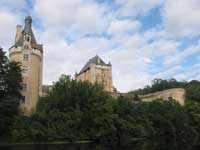 Along
the way to the next village, I passed by Touffou,
a castle first mentioned in the 12th century.
It was extensively rebuilt in the 17th century
to change it from a primarily defensive castle
into more or less a palace. Today it is owned
by the widow of the advertising magnate David
Ogilvy. It is really something else, see the
ariel photo: Along
the way to the next village, I passed by Touffou,
a castle first mentioned in the 12th century.
It was extensively rebuilt in the 17th century
to change it from a primarily defensive castle
into more or less a palace. Today it is owned
by the widow of the advertising magnate David
Ogilvy. It is really something else, see the
ariel photo:
https://www.pixaile.com/chateaux/slides/touffou4.htm
|
| 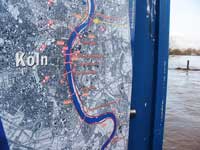 Last
winter, the Rhine came pretty close to overflowing
its banks, and somehow the idea of being able
to just walk down to the river with my canoe
on my back and step off the quay into it proved
irresistible. One more day of rain, and it would
have been over the banks, but in the event the
day dawned clear and relatively warm. I live
in Koln (Cologne in English) in the village
of Mulheim just north of the city center. Last
winter, the Rhine came pretty close to overflowing
its banks, and somehow the idea of being able
to just walk down to the river with my canoe
on my back and step off the quay into it proved
irresistible. One more day of rain, and it would
have been over the banks, but in the event the
day dawned clear and relatively warm. I live
in Koln (Cologne in English) in the village
of Mulheim just north of the city center.
|
| 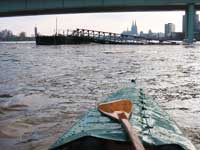 I
crossed the Rhine, which was flowing fast, something
like 6 - 8 knots with the high water, and made
my way upstream toward the old city in the slack
water along the banks. The steel structure is
a floating dock. The gangplank normally slopes
steeply down to a floating double-ended barge
that river boats tie up to. But this day the
river was about 19 feet above normal, and the
quay was about 3 feet underwater. I
crossed the Rhine, which was flowing fast, something
like 6 - 8 knots with the high water, and made
my way upstream toward the old city in the slack
water along the banks. The steel structure is
a floating dock. The gangplank normally slopes
steeply down to a floating double-ended barge
that river boats tie up to. But this day the
river was about 19 feet above normal, and the
quay was about 3 feet underwater.
|
| 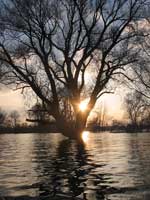 On
the way home I took a detour through the park
where I go with my girls to kick a soccer ball
around and let them throw stones in the river.
It was something else to see it all 6 feet underwater. On
the way home I took a detour through the park
where I go with my girls to kick a soccer ball
around and let them throw stones in the river.
It was something else to see it all 6 feet underwater.
|
| 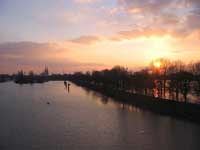 As
I was pottering my way through the park, I met
my friend Andreas on the bank of the river and
he took a couple of photos of me from the foot
bridge over the mouth of Mulheim Port. There
is a peninsula in the middle -- to the right
there is a port for the boats that maintain
the channel markers, ferries, dredgers and other
working boats. To the left there are a couple
of pleasure boat shops, and a big maintenance
railway that can take all but the biggest container
boats on the river for bottom jobs and general
repairs. As
I was pottering my way through the park, I met
my friend Andreas on the bank of the river and
he took a couple of photos of me from the foot
bridge over the mouth of Mulheim Port. There
is a peninsula in the middle -- to the right
there is a port for the boats that maintain
the channel markers, ferries, dredgers and other
working boats. To the left there are a couple
of pleasure boat shops, and a big maintenance
railway that can take all but the biggest container
boats on the river for bottom jobs and general
repairs.
|
| 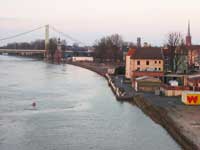 Heading
back in to the quay in front of my house. The
buildings on the right front, a miniature neighborhood,
were purpose built for the outdoor set of a
soap opera made by WDR, the national television
company. It is called Die AnRheiner -- the people
who live on the Rhine. I keep meaning to watch
it, but never seem to get around to it somehow. Heading
back in to the quay in front of my house. The
buildings on the right front, a miniature neighborhood,
were purpose built for the outdoor set of a
soap opera made by WDR, the national television
company. It is called Die AnRheiner -- the people
who live on the Rhine. I keep meaning to watch
it, but never seem to get around to it somehow.
|

Other Articles by Brian
Anderson:

|